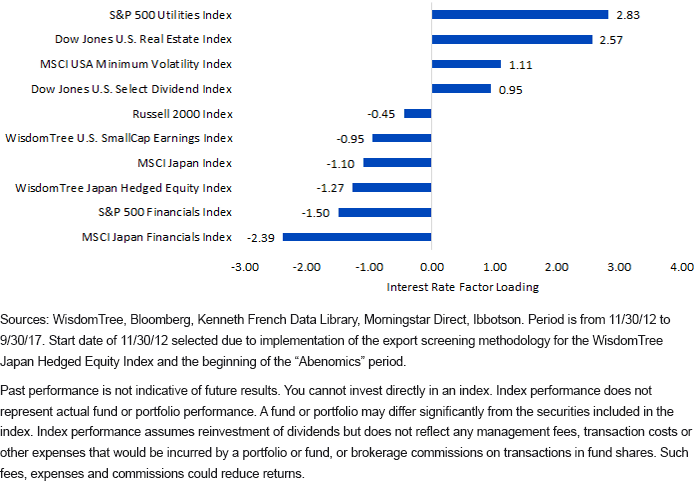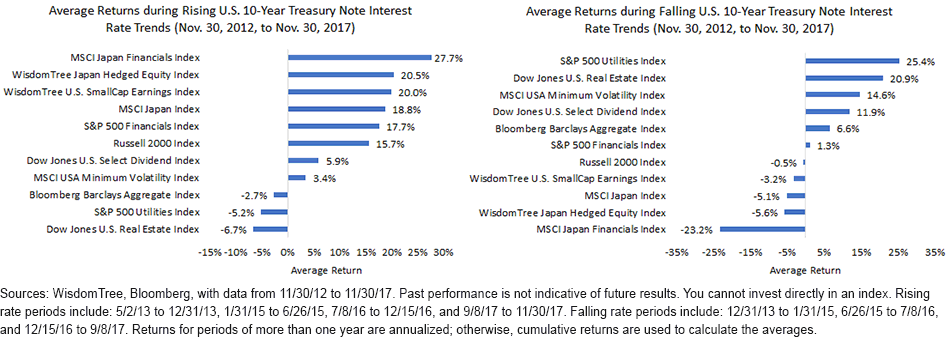An Unexpected Way to Benefit from Rising U.S. Interest Rates


While we all know that U.S. interest rates have, by and large, been in a downward trend since the early 1980s, over the past few years market participants have begun to think about positioning portfolios for rising interest rates.
As the markets prepare for a transition period in which the U.S. Federal Reserve (Fed) starts to reduce its balance sheet, talk of global accommodation from the European Central Bank (ECB) starts to wane and the U.S. government increases its deficit, we think it is helpful to consider strategies that are tied to interest rate sensitivity, as they can help investors align their equity portfolios with their interest rate viewpoints.
What Strategies Have Been the Best for Rising (or Falling) U.S. Interest Rates?
We chose a period from November 30, 2012, to September 30, 2017, and we utilized a regression analysis in order to see how effective fixed income returns were at explaining the variability of returns across a series of equity strategies. Specifically, our independent or explanatory variables were:
- Market Minus Risk-Free Rate: Typically, equity strategies have a sensitivity to movements of the broad market, so we wanted to isolate this factor in order to better zoom in on the sensitivity to shifting interest rates with our other variable.
- Interest Rates: Here, we utilized a measure of intermediate-maturity government bond1 returns such that NEGATIVE coefficients indicate that equities were going up when interest rates were going up (i.e., bond returns were going down) and POSITIVE coefficients indicate that equities are sensitive to falling interest rates, with prices of stocks and bonds moving together. Simply speaking, negatively oriented regression coefficients are leading us toward RISING rate strategies, whereas more positively oriented coefficients are leading us toward FALLING rate strategies.
The Surprise: Japanese Financials Had More Interest Rate Sensitivity than U.S. Financials
Interest Rate Sensitivity (Nov. 30, 2012, to Sept 30, 2017)

For definitions of indexes in the chart, visit our glossary.
As we zoom in on the coefficients of our interest rate factor, we can note:
- The MSCI Japan Financials Index has exhibited some of its strongest returns during rising rate periods, as noted by its -2.39 coefficient. In fact, over this nearly five-year period, Japanese Financials have indicated even greater sensitivity to rising U.S. interest rates than U.S. Financials, as seen by the S&P 500 Financials Index having a coefficient of -1.50.
- The WisdomTree Japan Hedged Equity Index is designed to exclude companies that derive more than 80% of their revenues from within Japan, thereby indicating an export tilt. Since the September 21, 2016, Bank of Japan policy of “yield curve control,”2 a rising rate picture in the U.S. 10-Year has been very closely related to a weakening of the Japanese yen against the U.S. dollar. It therefore makes sense that this strategy is a bit more sensitive to rising rates than the broad-based MSCI Japan Index benchmark.
- Rising interest rates do tend to have an association with increasing economic growth and increasing inflation. As long as the growth improvement is a major component of the equation, small-cap stocks also tend to respond. The WisdomTree U.S. SmallCap Earnings Index comprises profitable U.S. small caps, and the earnings-weighted approach is very highly geared to taking advantage of any price-to-earnings (P/E) multiple expansion, like what we saw in 2013 where the P/E multiple of this strategy went from 12.6x to 17.0x (approximately 35% multiple expansion!).3
How Did the Regression Coefficients Coincide with Returns?
Let’s connect these regression factor loadings to actual returns. Actual returns, of course, are what people care about.

- Japan: Since the beginning of the Abenomics period, the performance of Japan’s equities has ebbed and flowed, but if one were to ask what were the best times to allocate toward Japan, the data here suggests that it was clearly during rising U.S. rate periods. Financials and exporters did very well, on average, over these periods, as did U.S. small caps.
- Building Portfolios: Of course, predicting the direction of U.S. or any interest rates is challenging, but what this data also suggests is that an allocation to Japan could be a good hedge to any duration-sensitive assets—things like U.S. real estate,4 U.S. Utilities5 or U.S. minimum volatility.6 If used in concert, history has shown that a piece of a portfolio would have the potential to do well during both rising and falling rates.
Why It’s Important to Know Your Portfolio Sensitivities
In general, many investors have been over-weight yield-sensitive assets in recent years—from high-dividend stocks, Utilities, minimum-volatility stocks and just general exposure to bonds. As pressures build for rising interest rates, we believe investors should consider both Japanese broad market exposure and ETFs like the WisdomTree Japan Hedged Equity Fund (DXJ), as well as Japanese Financials, such as the WisdomTree Japan Hedged Financials Fund (DXJF), to supplement some other U.S.-sensitive rising rate plays like U.S. Financials.
1Refers to the Ibbotson Associates Stocks Bills Bonds & Inflation (SBBI) U.S. Intermediate Government Bond Total Return Index universe. Sources: Morningstar Direct, Ibbotson.
2Source: “New Framework for Strengthening Monetary Easing: ‘Quantitative and Qualitative Monetary Easing with Yield Curve Control,’” Bank of Japan, 9/21/16.
3Sources: WisdomTree, FactSet.4Refers to the Dow Jones U.S. Real Estate Index universe.
5Refers to the S&P 500 Utilities Index universe.
6Refers to the MSCI USA Minimum Volatility Index universe.
Important Risks Related to this Article
There are risks associated with investing, including possible loss of principal. Foreign investing involves special risks, such as risk of loss from currency fluctuation or political or economic uncertainty. The Funds focused on investments in Japan or certain sectors may be more vulnerable to any single economic, regulatory or sector-specific development, and increase the impact of events and developments in Japan that can adversely affect performance. This may result in greater share price volatility. Investments in currency involve additional special risks, such as credit risk and interest rate fluctuations. Derivative investments can be volatile, and these investments may be less liquid than other securities, and more sensitive to the effects of varied economic conditions. As this Fund can have a high concentration in some issuers, the Fund can be adversely impacted by changes affecting those issuers. Due to the investment strategy of this Fund, it may make higher capital gain distributions than other ETFs. Please read the Fund’s prospectus for specific details regarding the Fund’s risk profile.
Hedging can help returns when a foreign currency depreciates against the U.S. dollar, but it can hurt when the foreign currency appreciates against the U.S. dollar.
Neither MSCI nor any other party involved in or related to compiling, computing or creating the MSCI data makes any express or implied warranties or representations with respect to such data (or the results to be obtained by the use thereof), and all such parties hereby expressly disclaim all warranties of originality, accuracy, completeness, merchantability or fitness for a particular purpose with respect to any such data. Without limiting any of the foregoing, in no event shall MSCI, any of its affiliates or any third party involved in or related to compiling, computing or creating the data have any liability for any direct, indirect, special, punitive, consequential or any other damages (including lost profits), even if notified of the possibility of such.
The Global Industry Classification Standard (“GICS”) was developed by and is the exclusive property and a service mark of MSCI Inc. (“MSCI”) and Standard & Poor’s (“S&P”), a division of The McGraw-Hill Companies, Inc., and is licensed for use by WisdomTree Investments, Inc. Neither MSCI, S&P nor any other party involved in making or compiling the GICS or any GICS classifications makes any express or implied warranties or representations with respect to such standard or classification (or the results to be obtained by the use thereof), and all such parties hereby expressly disclaim all warranties of originality, accuracy, completeness, merchantability and fitness for a particular purpose with respect to any such standard or classification. Without limiting any of the foregoing, in no event shall MSCI, S&P, any of their affiliates or any third party involved in making or compiling the GICS or any GICS classifications have any liability for any direct, indirect, special, punitive, consequential or any other damages (including lost profits), even if notified of the possibility of such damages.

Christopher Gannatti began at WisdomTree as a Research Analyst in December 2010, working directly with Jeremy Schwartz, CFA®, Director of Research. In January of 2014, he was promoted to Associate Director of Research where he was responsible to lead different groups of analysts and strategists within the broader Research team at WisdomTree. In February of 2018, Christopher was promoted to Head of Research, Europe, where he was based out of WisdomTree’s London office and was responsible for the full WisdomTree research effort within the European market, as well as supporting the UCITs platform globally. In November 2021, Christopher was promoted to Global Head of Research, now responsible for numerous communications on investment strategy globally, particularly in the thematic equity space. Christopher came to WisdomTree from Lord Abbett, where he worked for four and a half years as a Regional Consultant. He received his MBA in Quantitative Finance, Accounting, and Economics from NYU’s Stern School of Business in 2010, and he received his bachelor’s degree from Colgate University in Economics in 2006. Christopher is a holder of the Chartered Financial Analyst Designation.

